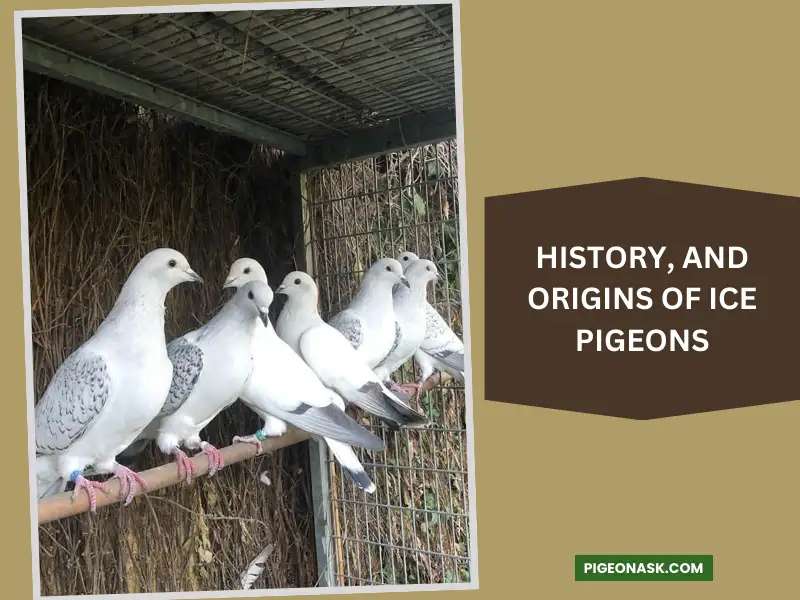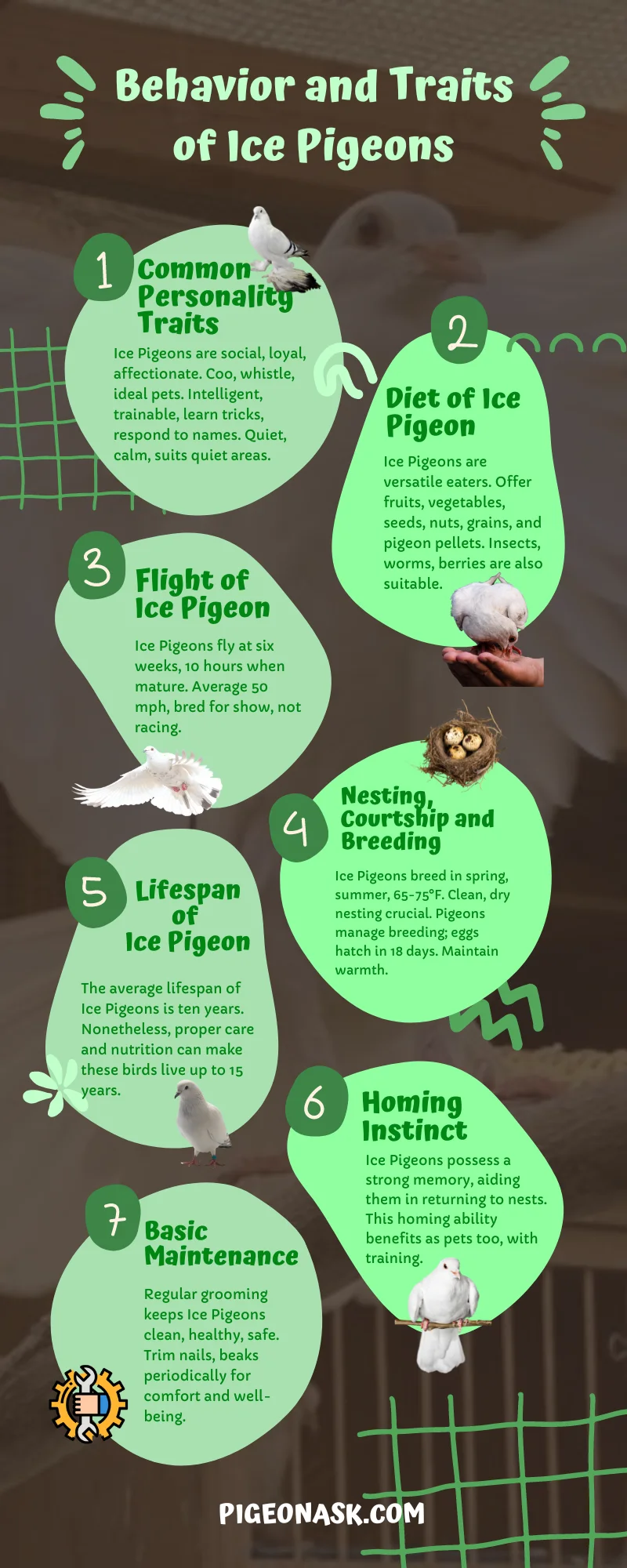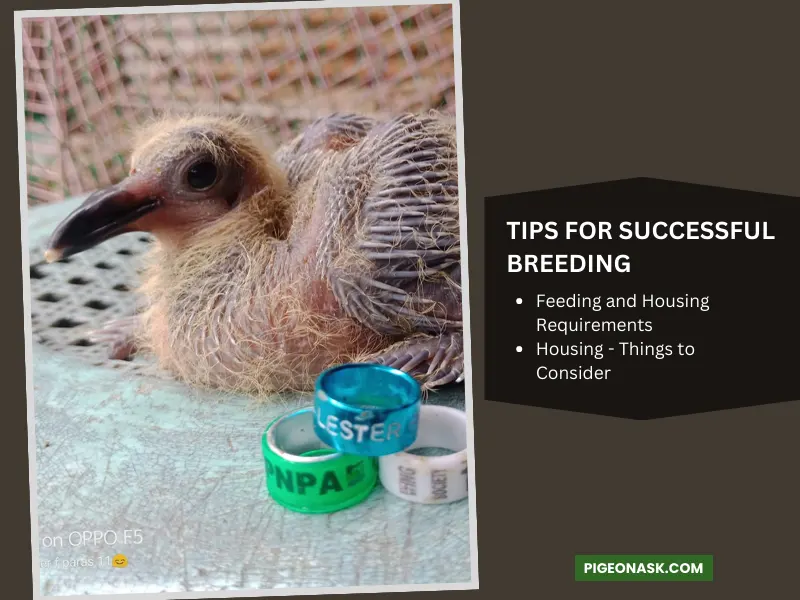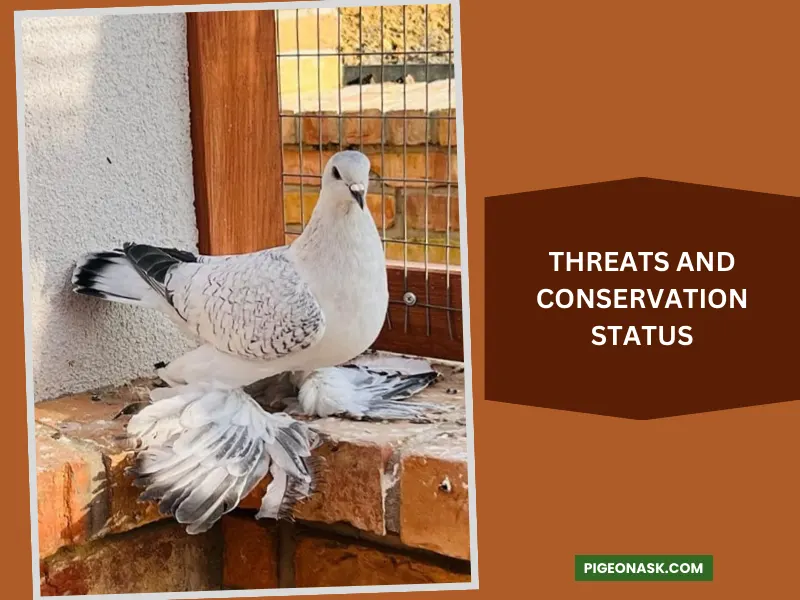Ice Pigeon: History And Breed Guide (With Infographic)
An Ice Pigeon is beautiful, but did you know it can also make for a great pet? Trained properly, this pigeon can learn many tricks and even respond to their names.
The Ice Pigeon is a type of fancy bird. While it isn’t a common pigeon in the United States, it’s easily available in parts of Europe like Germany and Poland.
The primary purpose for breeding this bird is for show purposes, the Ice Pigeon is a decent flyer and a loyal pet.
Want to know more about this pigeon, how to breed it, and more? Then stick around to learn everything you should know about it to breed them successfully!
Ice Pigeon Profile:
| Name | Ice Pigeon |
|---|---|
| Common Names: | Eistaube (Germany) Lazurek (Poland) |
| Origin: | Eastern Germany Western Poland |
| Size: | Average |
| Weight: | 400-600 Grams |
| Lifespan: | From 10 to 15 Years |
| Physical Features: | Oval-Shaped Head, Medium To Long Beaks, Broad Chest, Long Wings, Large Tails, Tiny Feet |
| Temperament: | Gentle |
| Behavior: | Loyal and Social |
| Special Features: | Ice-Blue Color |
| Breeding and Maintenance: | Easy Breeding Grooming Necessary |
| Common or Popular Varieties: | Hollow White-Binding Black-Binding Hammered White-Scooped |
Ice Pigeons are fancy birds bred as pets or for racing and show purposes. These pigeons are popular for their ice-blue color, which is why they get the “Ice Pigeon” name.
Looking for more articles about pigeon breed:
History, and Origins of Ice Pigeons
The Ice Pigeon is a descendant of the rock pigeon and developed after years of selective breeding.
Originally, this pigeon first appeared in Germany during the 19th century as the result of mixing the German Pouter and Cumulet birds, among others.

Afterward, the Ice Pigeon migrated to Western Poland. For this reason, records consider both Germany (Saxony) and Poland (Silesia) as the origin places of this bird.
One interesting reference about this pigeon is that Charles Darwin allegedly bred it in 1846. His goal was to ascertain patterns of color.
Physical Characteristics and Features
Ice Pigeons are birds of average size, sometimes even smaller than most other pigeons. Their usual weight is 400 grams but might grow to approximately 600 grams.

Let’s give you an overview of the common characteristics of the ice pigeons.
Appearance and Body Structure
The most common trait of the Ice Pigeon is the ice-blue coloration, which may appear as a pale gray to the human eye. This pigeon also has a unique head shape with an oval and smooth form.
As for the neck, Ice Pigeons have short necks stretched slightly to the front. This type of bird has a slender beak, usually with a dark color. Plus, the feet are adorably tiny!
Common Variations in Colors and Markings
One other thing to consider is the wing patterns, which can vary.
Behavior and Traits of Ice Pigeons
Here, we have evaluated common traits of the personality and behavior of Ice Pigeons.

Common Personality Traits
Ice Pigeons are social birds that enjoy the company of other pigeons and are very loyal to humans.
If you take good care of these pigeons, they may even show affection to you as their owner. They can coo or whistle as a sign of their good mood.
This breed of pigeons makes for excellent pets for this reason alone.
And this type of show pigeons are usually pretty intelligent. You can train Ice Pigeons and show them tricks, like identifying their nests and flying back.
Similarly, the birds can understand their names and come once called.
The pigeon is quiet and calm, and it barely makes any noise. This characteristic is perfect if you live close to people that won’t appreciate loud birds.
Diet
The Ice Pigeon is a bird that eats almost anything. Therefore, you can give them a diet of fruits, vegetables, seeds, nuts, and grains. Pellets for pigeons are also a suitable addition to their food.
Other than that, you can feed an Ice Pigeon with insects, worms, berries, and more.
Flight
Ice Pigeons develop flight ability as early as they’re six weeks old. When the pigeons are mature, their strong wings allow them to fly for ten hours straight without interruptions.
On average, this pigeon can fly approximately 50 miles per hour. While they’re good racers, racing is not the primary reason people breed Ice Pigeons.
Nesting, Courtship, and Breeding
Ice Pigeons usually prefer spring and summer for breeding. Similarly, the environment should be between 65-75 degrees Fahrenheit.
Breeding Ice Pigeons also requires proper nesting conditions to ensure the birds feel comfortable.
You can include a nesting box or platform to allow the female to lay the eggs. This area must be clean and dry. Likewise, you can insert straws, wood shavings, or other nesting materials for the pigeons.
As for the breeding, the pigeons take care of the procedure without complication. Afterward, the eggs need around 18 days to hatch. It’s essential to keep them in a warm environment throughout incubation.
Lifespan
The average lifespan of Ice Pigeons is ten years. Nonetheless, proper care and nutrition can make these birds live up to 15 years.
Homing Instinct
The memory of an Ice Pigeon is good, allowing them to remember the way back to their nests when they fly away. This homing instinct is equally good when you have this pigeon as a pet, but you must train it first.
Basic Maintenance
Regular grooming will guarantee your Ice Pigeons are clean, healthy, and safe. Periodically, you may have to consider trimming the nails and or beaks, a common practice necessary to ensure the birds live comfortably.
Tips and Considerations for Successful Breeding
Ice Pigeons are capable of breeding when they’re only six months old. Therefore, you can prepare beforehand to be ready.
Nonetheless, the breeding pair should be one year old at least. Also, evaluate health, physical features, and genetics before selecting.

Make sure the nests are at least one foot long. Plus, the nest bowl shall be approximately ten cm in diameter. An area this size will allow the baby birds to grow up comfortably.
Consider adding two nest boxes for every breeding pair. After breeding, you can use a commercial incubator or allow the breeding pairs to complete a natural incubation process.
Evaluate the eggs regularly thorough the incubation process to ensure they develop well.
Let the chicks live with their parents for four or six weeks before weaning. You can feed the youngsters with pigeon food and a diet high in protein.
Feeding and Housing Requirements
Feed your Ice Pigeons twice daily, providing enough water as they need. You could also create a feeding schedule that keeps the birds satisfied and compatible with your daily activities.
If you’re raising several, consider leaving the food inside the shelter. Monitor food consumption throughout the day and provide clean water early in the morning and during the night.
Housing – Things to Consider
The housing for Ice Pigeons does not need to be overly complicated or elaborate. Ideally, the only requirement to consider is that these birds must have enough space for their wingspan.
Thus, the area should be slightly larger than other pigeons usually demand. Typical dimensions for Ice Pigeons housing are eight feet by eight feet and at least six feet in height.
You can set up a loft or aviary as the perfect housing for Ice Pigeons. Another thing to remember is that the birds will need good ventilation and protection. Likewise, regular maintenance of the living area is necessary to prevent diseases caused by dirt or bacteria growth.
Threats and Conservation Status
The Ice Pigeon faces regular challenges that could risk their survival, like climate change. As a result, conservation efforts are necessary to protect the breed and its habitat.

For instance, humans must designate safe areas for the birds, perform studies to understand their needs, and raise awareness about the importance of conservation.
Frequently Asked Questions
1. Are ice pigeons found in any other countries besides Japan?
You can find Ice Pigeons in countries like Germany and Poland besides Japan.
2. What type of environment do ice pigeons prefer to live in?
Ice pigeons have been carefully bred to thrive in a range of climates, owing to their adaptation through selective breeding. With their origins rooted in South Germany, they exhibit a natural suitability for both temperate and colder weather conditions.
Final Word
The Ice Pigeon is for sure a pet for every breeder, regardless of your experience. If you’re a beginner, you can acquire these pigeons and be sure that they won’t be a hassle or demand considerable care.
You have to groom and trim their nails and beaks now and then, but that’s about it. For these reasons, we highly recommend Ice Pigeons for everyone into bird breeding.
Found this article helpful? Stay connected with us on our socials on Facebook, Twitter, and Pinterest for more educational pieces like this about the bird world and more!
Image Credits:
- https://twitter.com/YokaSiri
- https://pixabay.com/photos/
